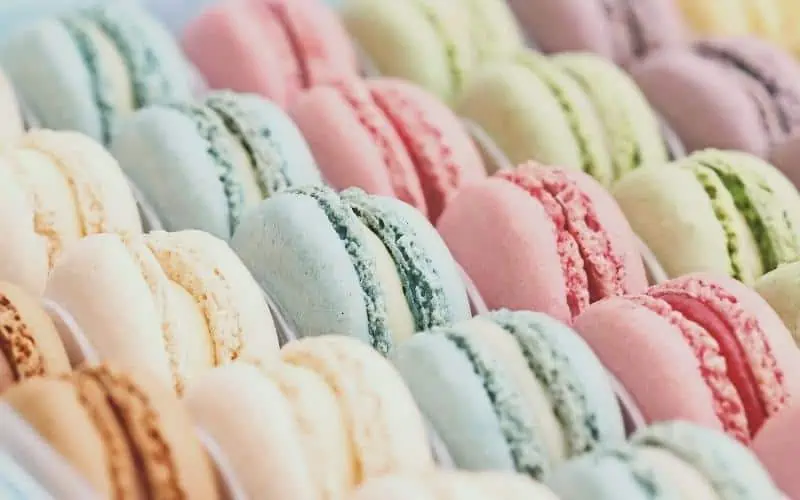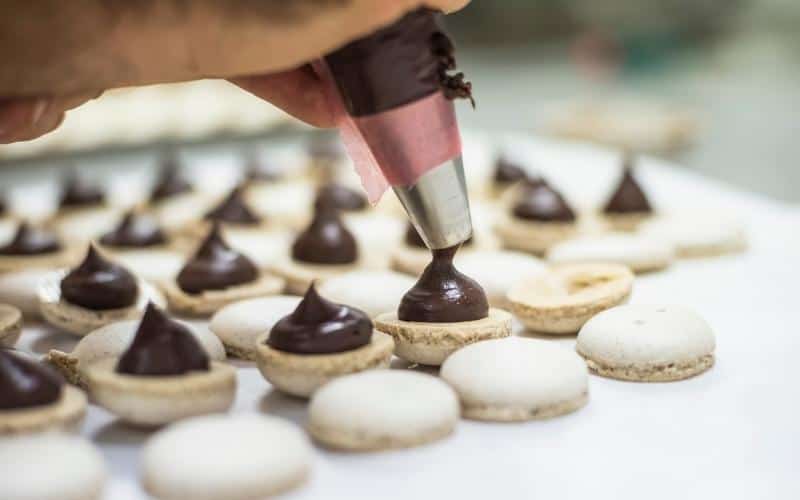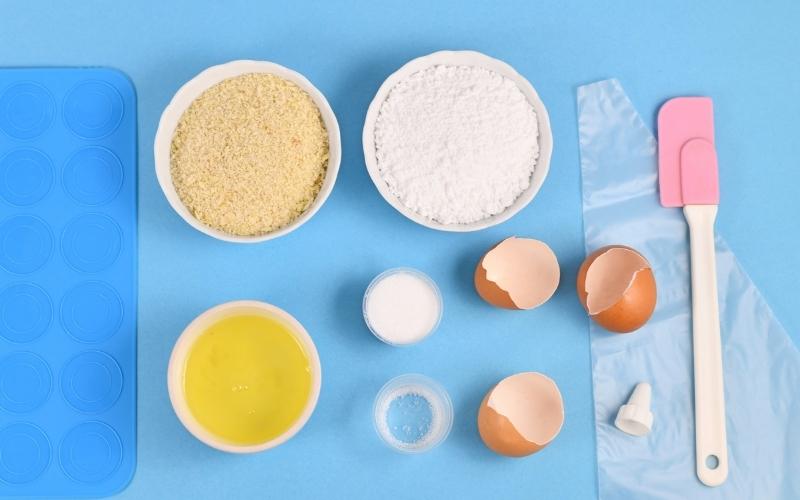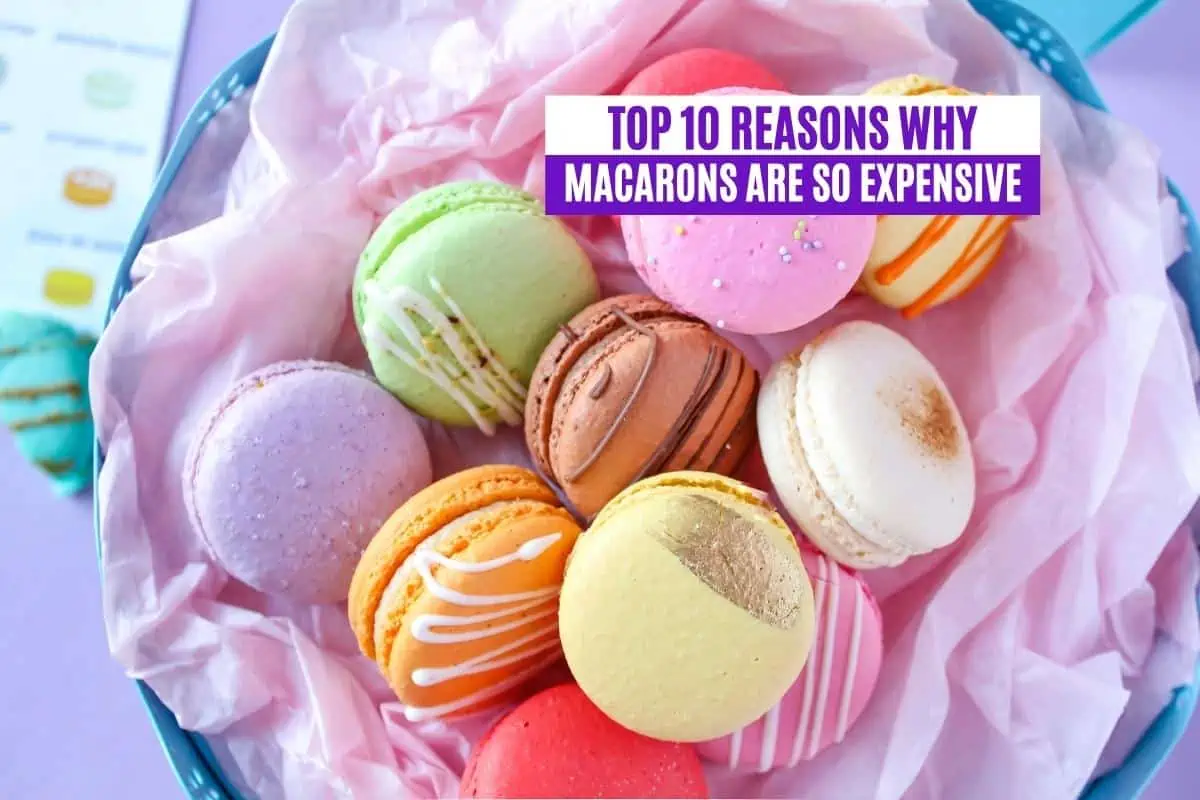Macarons (not to be confused with macaroons) are colorful sandwich-like desserts that have been popular since the Renaissance. But unlike prepackaged cookies and cakes, these tiny snacks tend to cost big bucks. But why are macarons so expensive?
Macarons are often pricier than other sweets because making them requires an exceptional skill level. Additionally, the ingredients used to create macarons are costlier than traditional dessert ingredients. Some macarons also feature uniquely expensive ingredients like gold leaf.
This guide will explore the primary reasons behind the macaron’s astoundingly high price. So the next time you’re in the mood for a delicate meringue-filled cookie, you’ll be able to appreciate both its exquisite flavor and its hefty price tag!
Here Are the Top 10 Reasons Why Macarons Are So Expensive:
- Only the most skilled chefs can make perfect macarons
- Some macarons feature decadent ingredients
- Almond flour is expensive
- Macarons are often made with aged eggs
- Macarons require pricey packaging
- Transporting macarons is challenging
- Making macarons is a time-consuming process
- Most macarons end up in the garbage
- Humid environments can increase preparation time
- Macarons don’t stay fresh for very long
10. Macarons Don’t Stay Fresh for Very Long

Most cookies and cakes stay fresh for several days or weeks, especially when kept in air-tight packaging. But macarons have a much shorter shelf life, typically degrading in quality after only a few days.
Unless you keep these unique sandwich cookies refrigerated, they’ll likely spoil within one week or less. Like the most expensive sushi, you’ll want to enjoy macarons immediately after they’re prepared. They taste best during the first three days after they’ve been baked.
Bakeries pay higher shipping costs to keep these cookies refrigerated during transport. Refrigeration helps them stay in tip-top condition. This transport cost increases each macaron’s price, making them more expensive than shelf-stable desserts.
Humidity is another factor affecting the price of macarons. While a relatively high humidity level can keep a macaron’s shells pleasantly soft, it can also impact the preparation process.
9. Humid Environments Can Increase Preparation Time
Creating macarons can be tricky if you live in an area prone to humidity. After all, macaron shell batter needs to be moist enough to flow from an icing bag but dry enough to settle into firm circles for baking. A humid kitchen can cause the shell batter to remain liquidy, preventing them from firming into bakeable shapes.
For this reason, chefs need to maintain the humidity inside their kitchens when preparing macarons. But controlling a kitchen’s humidity can be challenging and expensive. As a result, kitchens primed for macaron production incur higher electricity costs, forcing chefs to raise the prices of their delicious macarons.
8. Most Macarons End Up in the Garbage
Each step of the macaron creation process can result in imperfect shells or unusable fillings. For example, failing to let the macaron shells rest before baking, baking the shells in a humid oven, or whipping the filling too little (or too much) can ruin an otherwise perfect macaron.
Consequently, many macarons end up in the garbage due to minor flaws. This practice might seem like a waste, but it’s crucial to note that macarons are a dessert delicacy.
Therefore, when most folks order a macaron, they expect nothing less than perfection. Besides, macarons with cracked shells tend to dry out in just a few hours, resulting in a cookie sandwich that’s tough and overly crunchy. So tossing out broken macaron shells is common among top-tier chefs and bakers.
But the fact that a portion of each batch of macarons ends up in the trash raises the final price of the macarons that survived the preparation and baking process. Still, many chefs who create macarons do their best to minimize waste by passionately practicing their techniques and skills.
Unfortunately, ensuring that every batch of macarons looks picture-perfect and has the ideal consistency is a time-consuming process, which adds to the overall cost of making these delicate desserts.
7. Making Macarons Is a Time-Consuming Process

Preparing and baking a sheet of chocolate chip cookies might take about an hour. But making a few dozen macarons can take two hours, sometimes longer. Overall, creating tasty macarons is a time-consuming process, and it’s one that you can’t walk away from.
For example, you’ll need to mix the dry ingredients for the shell using a food processor, then sift those combined elements through a sieve. After that, you’ll need to use a mixer to beat egg whites and granulated sugar into a meringue-like consistency, taking several minutes.
If you accidentally overmix the egg whites and sugar, you’ll end up with a stiff paste that results in dried-out macaron shells. This process is one of the first steps that at-home bakers get wrong, and it can force you to start over from square one.
But every step of making macarons is time-consuming and challenging, from creating the batter to building the cookie sandwiches. Almost anything and everything can go wrong, spoiling your attempt and forcing you to try again.
Because macarons require so much time and labor to create, chefs tend to charge high prices for these cookies. And once a macaron is assembled and ready to eat, there’s another issue to consider: transportation.
6. Transporting Macarons Is Challenging
After spending hours producing a few dozen macarons, the last thing any chef wants is to see their hard work destroyed by poor packaging and rough shipping practices. But transporting delicate macarons to faraway destinations is challenging, as these cookies are particularly prone to cracking and spoiling.
The highest-quality macarons are transported in refrigerated vehicles by companies specializing in shipping sensitive goods. As you might expect, employing these services is far pricier than shipping via the USPS or other standard shipping companies.
And getting macarons to their destination quickly and safely doesn’t only mean hiring refrigerated truck services. These brightly colored sandwich cookies also require specialized packaging, which can be pretty expensive.
5. Macarons Require Pricey Packaging

You might be able to pick up a plastic bag of cookies from your local bakery, but you likely won’t ever find bagged macarons. That’s because these desserts are delicate and prone to crumbling and cracking. For that reason, they require specialized packaging to keep them in excellent condition.
Budget-friendly macarons are often packaged into plastic sleeves that hold each cookie in place. But luxury-quality macarons might sit inside handmade wooden cases or temperature-controlled boxes.
Additionally, many bakeries invest in customized packaging that costs more than generic packaging. These boxes and sleeves might feature the bakery’s brand name or logo.
The higher cost of this packaging is typically transferred to the customer via higher product prices. So, if you’re planning on ordering macarons from a niche bakery, you can expect to spend more than if you ordered from a chain bakery or a local small business.
4. Macarons Are Often Made With Aged Eggs

As we mentioned earlier, macarons are sensitive to humidity. Humid air can make the preparation process tricky, but excess moisture in the ingredients can result in overly wet fillings.
Excess moisture makes the shell batter runny and keeps it from setting correctly. The overly wet batter won’t form the neat circles that eventually become the macaron shells. It also won’t stiffen enough to allow it to bake.
Many bakers use aged egg whites to keep the shell batter somewhat firm and help it develop more quickly. When egg whites are exposed to air and allowed to age, they become dry, making them ideal for macaron shells.
Naturally, chefs can also choose to purchase dried egg whites. But dried egg whites are incredibly expensive. That’s because egg whites are mostly comprised of water.
Dehydrating egg whites can take hours, sometimes days! So, chefs have two options when making the filling for macarons.
They can age the egg whites themselves (which is time-consuming) or purchase pre-dried egg whites. Either option is expensive. Yet dried egg whites aren’t the most costly macaron ingredient.
3. Almond Flour Is Expensive
Making a macaron without almond flour would be like making a cake without flour or eggs! After all, almond flour is the primary ingredient used to make the colorful shells that protect a macaron’s filling.
But unlike all-purpose flour, which typically costs about $0.43 per pound, almond flour can cost upwards of $7 per pound. High-quality organic almond flour sometimes as much as $17 per pound!
Almond trees can take more than a decade to produce almonds, and they can be challenging to pollinate. As such, almonds are naturally pricier than legumes like peanuts. When you add the labor costs of turning whole almonds into soft flour, it’s easy to understand why almond flour is so expensive.
You’ll need about one cup of almond flour to make 60 macaron shells, but there’s a good chance you’ll throw out several of the shells due to cracking or shaping issues. So one cup of almond flour might only translate to about 20 finished macarons.
However, dried egg whites and almond flour aren’t the only high-cost ingredients that make macarons a pricey treat. Many macarons also feature rare and expensive spices, nuts, and fruits, raising their prices.
2. Some Macarons Feature Decadent Ingredients
All French macarons contain high-quality, expensive base ingredients like almond flour, dried egg whites, and powdered all-natural food colorings. But, like the most expensive ice creams, some macarons feature decadent and luxurious additional ingredients.
For example, some macarons are made with whipped coffee meringues. The coffee used to create these fillings are often sourced from organic coffee crops and hand-ground in the kitchen by world-class chefs.
Other macarons are made with pulverized pistachios. These treats feature light green shells and fillings infused with powdered pistachio. Notably, pistachios are some of the priciest nuts on the planet, so these macarons are inherently more expensive than chocolate or raspberry versions.
Still, over-the-top ingredients and add-ons aren’t the primary reasons macarons are costly snacks. These delicious desserts are incredibly challenging to get right, so only the most skilled chefs can make them.
1. Only the Most Skilled Chefs Can Make Perfect Macarons

Skill level is probably the most significant factor impacting the price of macarons. These colorful treats might look pretty straightforward, but creating the perfect macaron is a labor of love that can take years to master.
The best macarons come from experienced chefs and bakers that have spent hundreds (if not thousands) of hours practicing their macaron-making techniques. This high skill level requirement differentiates macarons from other baked goods like cookies and cakes.
Consider this: macaron shells have tiny ‘feet’ that only form when they’re allowed to rest before baking, spend a precise amount of time in the oven, and experience a sudden reduction of moisture while baking. Getting all of this right isn’t easy, as you’ll need to pay constant attention to your colorful cookie shells.
And if you create and bake the perfect macaron shells, you can mess everything up when it’s time to make the whipped meringue filling! A filling that’s too stiff will dry out quickly, resulting in an overly crunchy and tough macaron.
But a filling that’s too wet can soak into the shells, making for a soggy macaron. In short, the time, effort, and skill required to make delicious macarons make them far pricier than other tasty treats.
How Expensive Are Macarons?
The average price of a single macaron is about $2.50. You can get them for less, especially when purchasing a large quantity from a bulk store. But the highest-quality macarons are almost always $2 or more (per macaron).
Remember, part of this higher-than-average cost stems from the pricey ingredients required to make macarons. But a significant portion of the price results from packaging and labor costs.
Why Are Macarons So Expensive?
So, why are macarons so expensive? For one, they’re made of expensive ingredients. But preparation challenges also make macarons more costly than other desserts.
Even experienced bakers and chefs can struggle to make perfect macarons. Macaron shells are notoriously finicky, often cracking during the baking process. Many macarons end up in the trash, forcing the cost of well-made macarons ever higher.
If you enjoyed this article, check out these related articles about the world’s most expensive foods!

